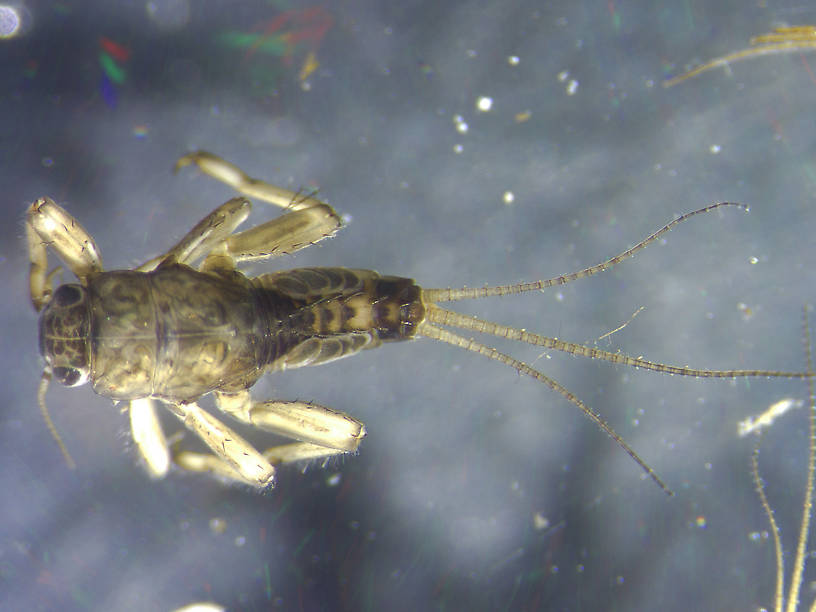
Salmonflies
Pteronarcys californica
The giant Salmonflies of the Western mountains are legendary for their proclivity to elicit consistent dry-fly action and ferocious strikes.
Featured on the forum

Nymphs of this species were fairly common in late-winter kick net samples from the upper Yakima River. Although I could not find a key to species of Zapada nymphs, a revision of the Nemouridae family by Baumann (1975) includes the following helpful sentence: "2 cervical gills on each side of midline, 1 arising inside and 1 outside of lateral cervical sclerites, usually single and elongate, sometimes constricted but with 3 or 4 branches arising beyond gill base in Zapada cinctipes." This specimen clearly has the branches and is within the range of that species.

Troutnut is a project started in 2003 by salmonid ecologist Jason "Troutnut" Neuswanger to help anglers and
fly tyers unabashedly embrace the entomological side of the sport. Learn more about Troutnut or
support the project for an enhanced experience here.
Identification: Key to Species of Caudatella Nymphs, Couplet 2
Identification: Key to Species of Caudatella Nymphs, Couplet 2
Adapted from Jacobus 2010 (2010)
| Option 1 | Option 2 |
|---|---|
| Paired medial spines on abdominal terga long and curved (at least on middle segments), some almost hook like | Paired medial spines on abdominal terga relatively straight, none longer than respective segment |
| Remaining species: Caudatella columbiella, Caudatella heterocaudata, and Caudatella jacobi | |
1 Example Specimen
This is a widely distributed species in western Montana but never abundant. Note the length of the middle tail, a key to the identification of this genus.
| |
| Caudatella hystrix | Go to Couplet 3 |
Adapted from Jacobus 2010 (2010)
The current couplet is highlighted with darker colors and a icon, and couplets leading to this point have a icon.
Leads to Caudatella edmundsi:
- Maxillary palp vestigial; tarsal claw with two prominent rows of denticles
Leads to Couplet 2:
- Maxillary palp with three distinct segments; tarsal claw with only one distinct row of denticles
Couplet 2
Couplet 2 (You are here)
Leads to Caudatella hystrix:
- Paired medial spines on abdominal terga long and curved (at least on middle segments), some almost hook like
Leads to Couplet 3:
- Paired medial spines on abdominal terga relatively straight, none longer than respective segment
Couplet 3
Leads to Caudatella jacobi:
- Cerci approximately two thirds length of median filament
- Abdominal sterna with solid color, never with longitudinal stripes or other such markings
Leads to Couplet 4:
- Cerci less than one-half length of median filament
- Abdominal sterna almost always with three dark, longitudinal markings
Couplet 4
Leads to Caudatella heterocaudata:
- Cerci approximately one-third length of median filament (about the length of the abdomen)
- Distinct pair of medial spines present only on abdominal terga 2–9, with the spine tips blunt
Leads to Caudatella columbiella:
- Cerci approximately one-sixth length of median filament (about half the length of the abdomen)
- Distinct pair of medial spines present on abdominal terga 1–9, with the spine tips sharp
Start a Discussion of this Couplet
References
- Baumann, Richard W. 1975. Revision of the Stonefly Family Nemouridae (plecoptera) : a Study Of The World Fauna At The Generic Level. Smithsonian Contributions to Zoology undef(211): 1-74.
- Jacobus, Luke M. 2010. Taxonomic Review of the Caudatella heterocaudata (McDunnough) and C. hystrix (Traver) Complexes (Insecta: Ephemeroptera: Ephemerellidae). Psyche: A Journal of Entomology 2010: 1-5.

